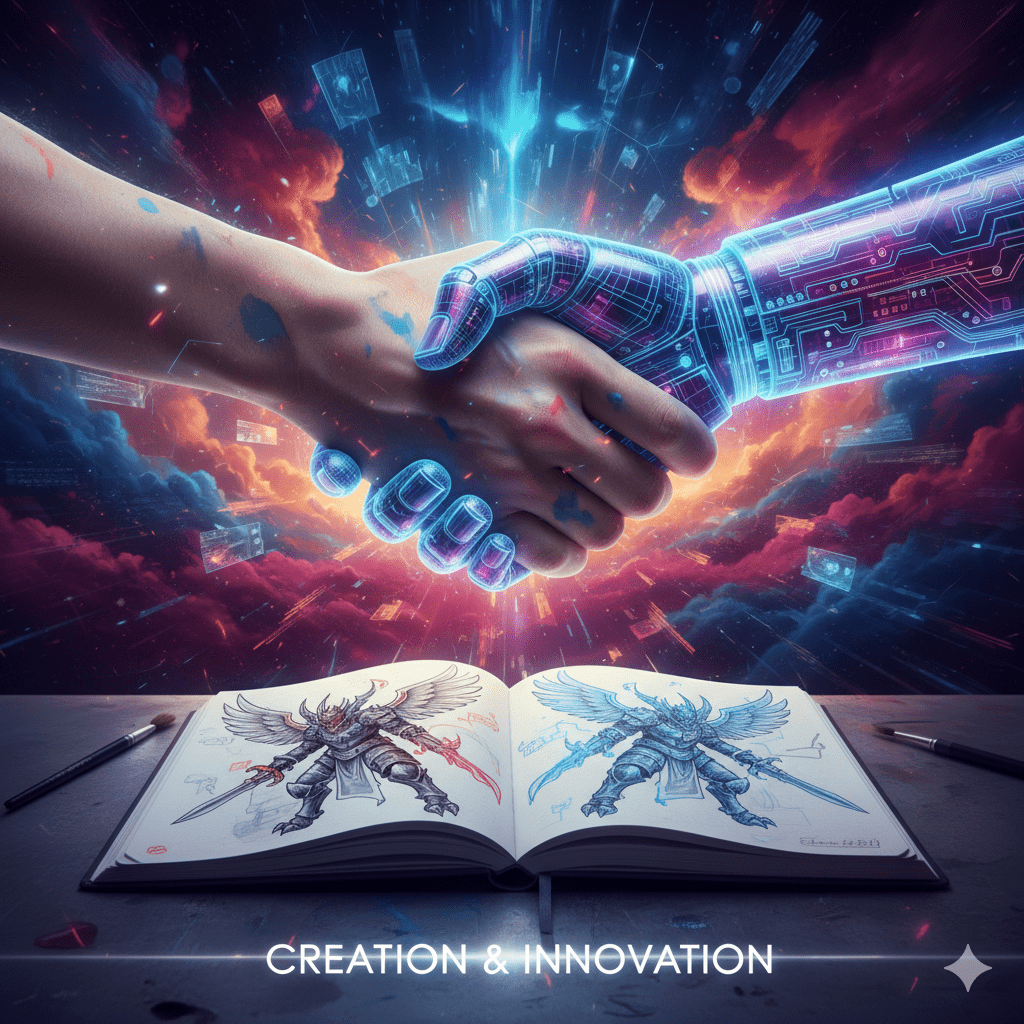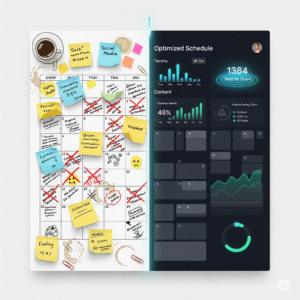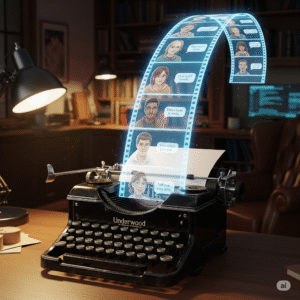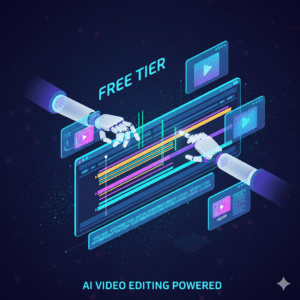Have you ever had a brilliant idea for a video game character—maybe a space pirate with a pet robot, or a tiny dragon that breathes ice—but felt stuck when it came to drawing them? You can see them perfectly in your mind, but getting that image onto a screen takes days, or even weeks, of hard work. (prompt for game character)
If you’re nodding your head, you’re just like our friend, a character designer named Maya. Maya was the best idea-person around, but she could only draw so fast. Her brilliant ideas often piled up faster than she could sketch them, making her feel like a creative factory running at half speed. This is a common problem for all creators: the speed of imagination often leaves the speed of execution in the dust.
But then, Maya discovered the secret weapon that changed everything: Artificial Intelligence (AI), specifically, how to write the perfect prompt for game character creation.
This guide is designed to take the mystery out of AI art. We’re going to explain the magic like you’re 10 years old, diving deep into the technical bits with simple analogies. By the end, you’ll not only understand how AI works but you’ll have a 5-step formula for writing a prompt for game character that turns your wildest imagination into stunning, game-ready visuals in minutes.
1. The Story of the Magical Chef: Understanding AI and Creativity
Before we jump into the formula, let’s understand the two main stars of our show: AI and the Prompt.
What Exactly is AI? (The Magical Chef Analogy)
Imagine you have a Magical Chef in your kitchen. This chef has read every cookbook ever written, seen every cooking show, and knows exactly what certain words mean. If you ask for a “fluffy, golden-brown pancake,” the chef knows exactly what ingredients, tools, and heat settings to use to make it perfect.
- The Magical Chef (The AI Model): This is the computer program (like Gemini, Midjourney, or Stable Diffusion) that creates the image. It doesn’t actually think like you and me. Instead, it uses a massive library of pictures it has studied (trillions of them!) to know what a “space pirate” looks like, what “cyberpunk style” means, and how “glowing purple eyes” should be drawn.
- The Cookbook (The Training Data): This is the huge collection of images the AI studied. When you ask it to draw something, it doesn’t copy—it mixes and matches ideas from its “cookbook” to make something brand new, just like a chef creates a new dish from existing ingredients. This is what we mean by AI and creativity—it’s not replacing your ideas, it’s synthesizing them.
What is a Prompt? (The Perfect Recipe Card)
The prompt for game character creation is your instruction manual for the Magical Chef. If you just ask for “a hero,” the chef might give you something boring, like a stick figure. But if you give a detailed, perfect recipe card, you get exactly what you want.
A good prompt is like a detailed recipe card that tells the AI:
- The Ingredients (The Subject): What is the character? (e.g., A dwarf warrior, a futuristic rogue).
- The Cooking Style (The Art Style): How should it look? (e.g., Cinematic lighting, pixel art, watercolor).
- The Presentation (The Details): What special features does it have? (e.g., Glowing sword, torn cloak, sitting on a throne).
This detailed recipe is the foundation of human-AI collaboration for creators. You provide the deep, unique vision, and the AI provides the lightning-fast execution.
2. Maya’s Problem: When AI Gets It Wrong
Maya started her journey by trying simple prompts. She typed: “Cool elf girl.” The AI gave her five pictures of generic, pretty elves. They were nice, but they weren’t her elf. They lacked the “soul” she had imagined. Her problem, and the problem many face, was the lack of detail.
The AI, like our Magical Chef, only knows what you tell it. If you say “make soup,” the soup might be bland. But if you say “make spicy Thai coconut soup with chicken, lime leaves, and a swirl of chili oil,” the result is specific and delicious.
The Deep Dive into Prompt Engineering
- Prompt Engineering sounds like a big, complicated job title, but it simply means learning how to talk to the AI effectively. It’s about being precise. You are learning the AI’s language.
- Every word in your prompt for game character has a “weight.” Stronger, more descriptive words push the AI toward a specific result. Words like “Epic,” “Cinematic,” or “Photorealistic” are like turning up the heat on the oven—they intensify the result.
This is where the 5-Step Formula comes in, turning guesswork into a predictable, fast, and highly effective part of your creative workflow automation.
3. The 5-Step Formula for the Perfect Prompt for Game Character
To master prompt for game character creation, we break the process down into five clear, easy-to-manage parts. Think of this as filling out the sections of your ultimate character sheet for the AI.
Step 1: The Core Subject (The ‘Who’ and ‘What’)
Start simple and specific. This is the most important part because it sets the AI’s foundation.
- Rule: Always identify the Character Type and the Race/Class.
- Simple Example: A rugged space bounty hunter.
- Better Example: An elderly Dwarven blacksmith, standing in a lava-lit forge.
Keywords to Focus On:
- Races: Elf, Goblin, Orc, Human, Cyborg, Alien, Mecha, Beastman.
- Classes/Roles: Warrior, Mage, Rogue, Pilot, Scientist, Priestess, Diplomat.
Step 2: Key Defining Features (The ‘Details’ and ‘Personality’)
This is where you inject the character’s story and unique traits. What makes them different?
- Rule: Describe their Costume, Equipment, and Vibe. Think about the materials.
- Simple Example: Wears leather armor.
- Better Example: Wears heavily weathered, black leather armor, accented with glowing blue neon straps and a gas mask. He looks tired but determined. (This is crucial for strong AI and creativity results.)
Keywords to Focus On:
- Material: Rusty metal, woven cotton, enchanted silk, carbon fiber, obsidian.
- State: Battle-worn, pristine, patched, tattered, futuristic.
- Emotion: Frowning, stoic, confident, chaotic, wise, menacing.
Step 3: Setting and Environment (The ‘Where’ and ‘When’)
The background tells the AI how to light and color the character. A fantasy character should look different from a cyberpunk character because of the world around them.
- Rule: Describe the Location and the Lighting/Atmosphere.
- Simple Example: In a forest.
- Better Example: Standing on a rooftop overlooking a neon-drenched cyberpunk city at midnight, the scene is illuminated by a harsh, blue rim light.
Keywords to Focus On:
- Location: Floating sky city, crumbling ruins, deep sea trench, ancient temple.
- Lighting: Volumetric light, dramatic backlighting, soft studio light, golden hour, deep shadow.
Step 4: Art Style and Medium (The ‘How It Looks’)
This step guides the Magical Chef on how to prepare the image. Do you want a painting, a sketch, or something that looks like a high-end 3D model?
- Rule: Specify the Art Medium and Camera Shot.
- Simple Example: A digital painting.
- Better Example: Ultra-detailed digital painting, concept art for a video game, 8K resolution, full body shot, detailed character sheet.
Keywords to Focus On:
- Medium: Hyperrealistic, oil painting, anime style, Pixar style, low-poly 3D render.
- Shot: Portrait, full body, close-up, wide shot, action pose.
Step 5: Modifiers and Quality (The ‘Magic Dust’)
These are the “SEO keywords” for the AI—words that ensure high quality and professional finishing. These are the evergreen keywords that boost any prompt for game character you write.
- Rule: Add quality terms and exclude things you don’t want.
- Universal Terms: Unreal Engine, ZBrush, Octane Render, insanely detailed, professional, trending on ArtStation.
- The Negative Prompt (What NOT to draw): To keep the image clean, use this list: blur, grainy, distorted, bad hands, low resolution.
| Summary: The Ultimate Prompt for Game Character Template |
|---|
(1) Core Subject: A fearless, young Elven Ranger |
(2) Key Features: wearing enchanted green leather armor, carrying a glowing bow and quiver of ice arrows. |
(3) Environment: Standing on a moss-covered cliff edge, with mist rolling in at sunrise. |
(4) Art Style: Highly detailed 3D render, final concept art, photorealistic. |
(5) Modifiers: Unreal Engine, cinematic lighting, 8K. --no blurry, ugly, distorted. |
4. The Power of Human-AI Collaboration for Creators
Maya implemented this 5-step formula. She went from getting generic elves to getting precisely rendered, unique fantasy warriors that fit perfectly into her game’s world. This unlocked genuine human-AI collaboration for creators.
A. Real-World Applications: Speeding Up the Creative Factory
The real magic of using a precise prompt for game character is its impact on the time it takes to go from idea to asset.
- Indie Game Development (The Speed Test): A small studio might spend 40 hours developing a single high-quality character concept. By integrating AI and mastering the prompt, they can generate 10 high-quality, fully realized concepts in less than 4 hours. This massive increase in efficiency directly contributes to creative workflow automation. They use AI to quickly validate an idea before a human artist spends days finalizing it.
- Marketing & Advertising (The Visual Library): Large studios, like those referencing a hypothetical OpenAI or McKinsey study on digital asset creation, are using prompt engineering not just for main characters, but for background characters, non-player characters (NPCs), and even promotional art. They generate thousands of visually consistent assets quickly, ensuring their brand messaging is coherent across all platforms—from a billboard to a tiny mobile game icon. This is a crucial element of modern AI and creativity.
- Concept Artists (The Idea Generator): Professional concept artists aren’t being replaced; they’re becoming “AI Conductors.” They use the detailed prompt for game character to generate initial images, which they then treat as a high-fidelity sketch. They paint over the AI’s image, guiding the final output and retaining 100% of the creative control while drastically reducing the time spent on initial blocking and composition. This elevates the human-AI collaboration for creators.
5. Tools of the Trade and Final Expert Tips
To truly master the prompt for game character workflow, you need the right tools—the right kitchens for our Magical Chef.
B. Essential AI Tool Recommendations
Here are a few popular tools you can use to start your creative workflow automation:
- 1. Midjourney: Known for its highly aesthetic, artistic, and cinematic results. It’s excellent for fantasy and sci-fi characters that need a “wow” factor.
- 2. Stable Diffusion (Various Models): This tool offers more control and allows users to run it locally or use specialized models that focus specifically on game art styles (e.g., pixel art, isometric views). It’s perfect for detailed, technical character creation.
- 3. Leonardo AI: Great for beginners, as it has pre-set “Art Styles” and an easy-to-use interface, making it simple to create your first prompt for game character without needing complex modifier keywords.
C. Advanced Tips for Next-Level Character Prompts
Once you’ve mastered the 5-step formula, use these expert tips to push the boundaries of AI and creativity:
- Use Weighting (The Double Colon): Most AI tools let you assign importance to a word. By using
::, you tell the AI which part of your prompt for game character is most important.- Example:
space pirate ::5 armored alien ::1(Tells the AI: Focus 5x more on the pirate than the alien.)
- Example:
- Reference Real Artists (Style Shorthand): If you like the mood or style of a specific, famous (and usually deceased) artist or a famous game studio, you can use their name as a style modifier.
- Example:
...in the style of Final Fantasy concept art, inspired by Albrecht Dürer.(This gives the AI a powerful, specific art direction.)
- Example:
- The “Fix My Hands” Trick (The Negative Prompt): AI models often struggle with drawing realistic hands. Always use negative prompt modifiers to tell the AI to avoid them.
- Example: Add
--no hands, fingers, deformed, extra limbto your prompt’s end. This is a hallmark of good prompt engineering.
- Example: Add
- Batch and Iterate (The 10:1 Rule): Don’t stop at the first result. Write a good prompt for game character and generate 4-8 versions. Pick the best one and use its style or seed number to generate more versions. Think of it as generating 10 variations to find 1 masterpiece—it’s fast, thanks to creative workflow automation.
- Prompt for Gaming Name: The Secret Code💡
6. The Future of Creative Workflow Automation
When Maya finally finished her first batch of AI-generated characters, she didn’t feel like a cheater; she felt like an editor of possibilities. She was no longer held back by the slow pace of drawing. She was directing a powerful creative engine, focusing her energy on the high-level vision and narrative, rather than the tedious details of rendering. This is the true meaning of human-AI collaboration for creators.
Prompt for Gaming Logo: The 1-Hour Secret to a Killer Mascot (Even if You Can’t Draw!) 🎮💡
The fear that AI will replace artists misses the point. AI is a bicycle for the mind—a tool that lets us travel farther and faster than ever before. For anyone in the gaming industry, understanding how to write a great prompt for game character isn’t just a skill; it’s the new baseline for creative workflow automation.
By mastering these five simple steps, you are not just typing words; you are speaking the language of the future of design. You are taking your brilliant ideas—your elderly dwarven blacksmiths and your space pirates—and giving them a direct line to the fastest artist in the world. Now, go forth and start creating your next masterpiece!
r/OpenAI – It took me 7 prompts to create a game character …



